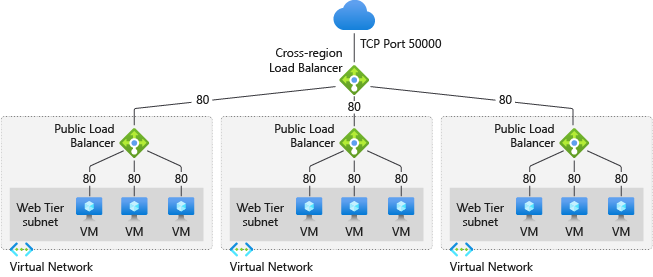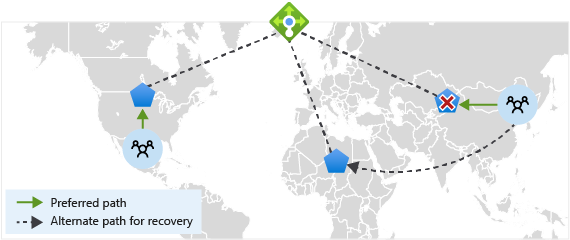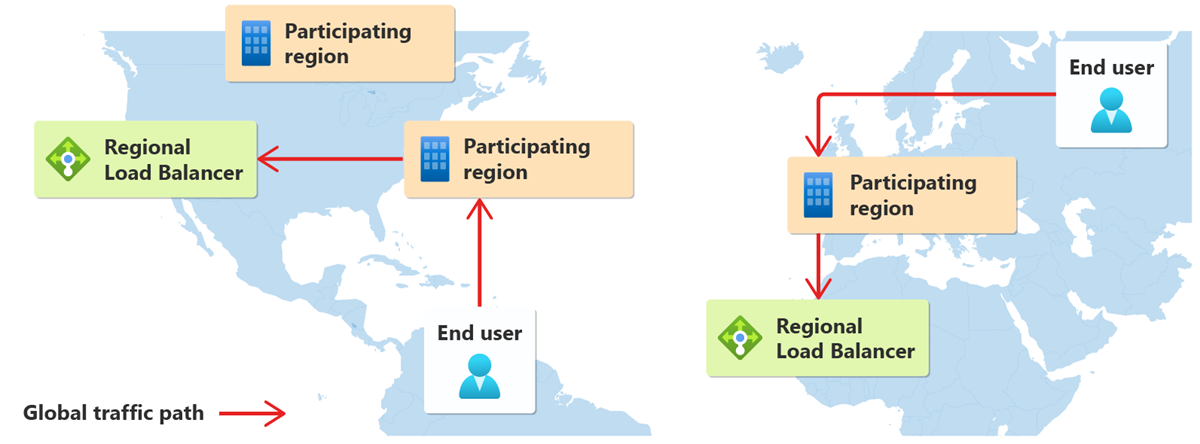Reliability in Load Balancer
This article contains detailed information on Load Balancer regional resiliency with availability zones and cross-region disaster recovery and business continuity.
Availability zone support
Availability zones are physically separate groups of datacenters within each Azure region. When one zone fails, services can fail over to one of the remaining zones.
For more information on availability zones in Azure, see What are availability zones?
Azure Load Balancer supports availability zones scenarios. You can use Standard Load Balancer to increase availability throughout your scenario by aligning resources with, and distribution across zones. Review this document to understand these concepts and fundamental scenario design guidance.
Although it's recommended that you deploy Load Balancer with zone-redundancy, a Load Balancer can either be zone redundant, zonal, or non-zonal. The load balancer's availability zone selection is synonymous with its frontend IP's zone selection. For public load balancers, if the public IP in the Load balancer's frontend is zone redundant then the load balancer is also zone-redundant. If the public IP in the load balancer's frontend is zonal, then the load balancer will also be designated to the same zone. To configure the zone-related properties for your load balancer, select the appropriate type of frontend needed.
Note
It isn't required to have a load balancer for each zone, rather having a single load balancer with multiple frontends (zonal or zone redundant) associated to their respective backend pools will serve the purpose.
Prerequisites
To use availability zones with Load Balancer, you need to create your load balancer in a region that supports availability zones. To see which regions support availability zones, see the list of supported regions.
Use Standard SKU for load balancer and Public IP for availability zones support.
Basic SKU type isn't supported.
To create your resource, you need to have Network Contributor role or higher.
Limitations
- Zones can't be changed, updated, or created for the resource after creation.
- Resources can't be updated from zonal to zone-redundant or vice versa after creation.
Zone redundant load balancer
In a region with availability zones, a Standard Load Balancer can be zone-redundant with traffic served by a single IP address. A single frontend IP address survives zone failure. The frontend IP may be used to reach all (non-impacted) backend pool members no matter the zone. Up to one availability zone can fail and the data path survives as long as the remaining zones in the region remain healthy.
The frontend's IP address is served simultaneously by multiple independent infrastructure deployments in multiple availability zones. Any retries or reestablishment will succeed in other zones not affected by the zone failure.

Note
VMs 1,2, and 3 can be belong to the same subnet and don't necessarily have to be in separate zones as the diagram suggestions.
Members in the backend pool of a load balancer are normally associated with a single zone such as with zonal virtual machines. A common design for production workloads would be to have multiple zonal resources. For example, placing virtual machines from zone 1, 2, and 3 in the backend of a load balancer with a zone-redundant frontend meets this design principle.
Zonal load balancer
You can choose to have a frontend guaranteed to a single zone, which is known as a zonal. With this scenario, a single zone in a region serves all inbound or outbound flow. Your frontend shares fate with the health of the zone. The data path is unaffected by failures in zones other than where it was guaranteed. You can use zonal frontends to expose an IP address per Availability Zone.
Additionally, the use of zonal frontends directly for load-balanced endpoints within each zone is supported. You can use this configuration to expose per zone load-balanced endpoints to individually monitor each zone. For public endpoints, you can integrate them with a DNS load-balancing product like Traffic Manager and use a single DNS name.

For a public load balancer frontend, you add a zones parameter to the public IP. This public IP is referenced by the frontend IP configuration used by the respective rule.
For an internal load balancer frontend, add a zones parameter to the internal load balancer frontend IP configuration. A zonal frontend guarantees an IP address in a subnet to a specific zone.
Non-zonal load balancer
Load Balancers can also be created in a non-zonal configuration by use of a "no-zone" frontend. In these scenarios, a public load balancer would use a public IP or public IP prefix, an internal load balancer would use a private IP. This option doesn't give a guarantee of redundancy.
Note
All public IP addresses that are upgraded from Basic SKU to Standard SKU will be of type "no-zone". Learn how to Upgrade a public IP address in the Azure portal.
SLA improvements
Because availability zones are physically separate and provide distinct power source, network, and cooling, SLAs (Service-level agreements) can increase. For more information, see the Service Level Agreements (SLA) for Online Services.
Create a resource with availability zone enabled
To learn how to load balance VMs within a zone or over multiple zones using a Load Balancer, see Quickstart: Create a public load balancer to load balance VMs.
Note
- Zones can't be changed, updated, or created for the resource after creation.
- Resources can't be updated from zonal to zone-redundant or vice versa after creation.
Fault tolerance
Virtual machines can fail over to another server in a cluster, with the VM's operating system restarting on the new server. You should refer to the failover process for disaster recovery, gathering virtual machines in recovery planning, and running disaster recovery drills to ensure their fault tolerance solution is successful.
For more information, see the site recovery processes.
Zone down experience
Zone-redundancy doesn't imply hitless data plane or control plane. Zone-redundant flows can use any zone and your flows will use all healthy zones in a region. In a zone failure, traffic flows using healthy zones aren't affected.
Traffic flows using a zone at the time of zone failure may be affected but applications can recover. Traffic continues in the healthy zones within the region upon retransmission when Azure has converged around the zone failure.
Review Azure cloud design patterns to improve the resiliency of your application to failure scenarios.
Multiple frontends
Using multiple frontends allow you to load balance traffic on more than one port and/or IP address. When designing your architecture, ensure you account for how zone redundancy interacts with multiple frontends. If your goal is to always have every frontend resilient to failure, then all IP addresses assigned as frontends must be zone-redundant. If a set of frontends is intended to be associated with a single zone, then every IP address for that set must be associated with that specific zone. A load balancer isn't required in each zone. Instead, each zonal front end, or set of zonal frontends, could be associated with virtual machines in the backend pool that are part of that specific availability zone.
Safe deployment techniques
Review Azure cloud design patterns to improve the resiliency of your application to failure scenarios.
Migrate to availability zone support
In the case where a region is augmented to have availability zones, any existing IPs would remain non-zonal like IPs used for load balancer frontends. To ensure your architecture can take advantage of the new zones, it's recommended that you create a new frontend IP. Once created, you can replace the existing non-zonal frontend with a new zone-redundant frontend. To learn how to migrate a VM to availability zone support, see Migrate Load Balancer to availability zone support.
Cross-region disaster recovery and business continuity
Disaster recovery (DR) is about recovering from high-impact events, such as natural disasters or failed deployments that result in downtime and data loss. Regardless of the cause, the best remedy for a disaster is a well-defined and tested DR plan and an application design that actively supports DR. Before you begin to think about creating your disaster recovery plan, see Recommendations for designing a disaster recovery strategy.
When it comes to DR, Microsoft uses the shared responsibility model. In a shared responsibility model, Microsoft ensures that the baseline infrastructure and platform services are available. At the same time, many Azure services don't automatically replicate data or fall back from a failed region to cross-replicate to another enabled region. For those services, you're responsible for setting up a disaster recovery plan that works for your workload. Most services that run on Azure platform as a service (PaaS) offerings provide features and guidance to support DR and you can use service-specific features to support fast recovery to help develop your DR plan.
Azure Standard Load Balancer supports cross-region load balancing enabling geo-redundant high availability scenarios such as:
- Incoming traffic originating from multiple regions.
- Instant global failover to the next optimal regional deployment.
- Load distribution across regions to the closest Azure region with ultra-low latency.
- Ability to scale up/down behind a single endpoint.
- Static anycast global IP address
- Client IP preservation
- Build on existing load balancer solution with no learning curve
The frontend IP configuration of your cross-region load balancer is static and advertised across most Azure regions.

Note
The backend port of your load balancing rule on cross-region load balancer should match the frontend port of the load balancing rule/inbound nat rule on regional standard load balancer.
Disaster recovery in multi-region geography
Regional redundancy
Configure regional redundancy by seamlessly linking a cross-region load balancer to your existing regional load balancers.
If one region fails, the traffic is routed to the next closest healthy regional load balancer.
The health probe of the cross-region load balancer gathers information about availability of each regional load balancer every 5 seconds. If one regional load balancer drops its availability to 0, cross-region load balancer detects the failure. The regional load balancer is then taken out of rotation.

Ultra-low latency
The geo-proximity load-balancing algorithm is based on the geographic location of your users and your regional deployments.
Traffic started from a client hits the closest participating region and travel through the Microsoft global network backbone to arrive at the closest regional deployment.
For example, you have a cross-region load balancer with standard load balancers in Azure regions:
- West US
- North Europe
If a flow is started from Seattle, traffic enters West US. This region is the closest participating region from Seattle. The traffic is routed to the closest region load balancer, which is West US.
Azure cross-region load balancer uses geo-proximity load-balancing algorithm for the routing decision.
The configured load distribution mode of the regional load balancers is used for making the final routing decision when multiple regional load balancers are used for geo-proximity.
For more information, see Configure the distribution mode for Azure Load Balancer.
Egress traffic follows the routing preference set on the regional load balancers.
Ability to scale up/down behind a single endpoint
When you expose the global endpoint of a cross-region load balancer to customers, you can add or remove regional deployments behind the global endpoint without interruption.
Static anycast global IP address
Cross-region load balancer comes with a static public IP, which ensures the IP address remains the same. To learn more about static IP, read more here
Client IP Preservation
Cross-region load balancer is a Layer-4 pass-through network load balancer. This pass-through preserves the original IP of the packet. The original IP is available to the code running on the virtual machine. This preservation allows you to apply logic that is specific to an IP address.
Floating IP
Floating IP can be configured at both the global IP level and regional IP level. For more information, visit Multiple frontends for Azure Load Balancer
It is important to note that floating IP configured on the Azure cross-region Load Balancer operates independently of floating IP configurations on backend regional load balancers. If floating IP is enabled on the cross-region load balancer, the appropriate loopback interface needs to be added to the backend VMs.
Health Probes
Azure cross-region Load Balancer utilizes the health of the backend regional load balancers when deciding where to distribute traffic to. Health checks by cross-region load balancer are done automatically every 5 seconds, given that a user has set up health probes on their regional load balancer.
Build cross region solution on existing Azure Load Balancer
The backend pool of cross-region load balancer contains one or more regional load balancers.
Add your existing load balancer deployments to a cross-region load balancer for a highly available, cross-region deployment.
Home region is where the cross-region load balancer or Public IP Address of Global tier is deployed. This region doesn't affect how the traffic is routed. If a home region goes down, traffic flow is unaffected.
Home regions
- Central US
- East Asia
- East US 2
- North Europe
- Southeast Asia
- UK South
- US Gov Virginia
- West Europe
- West US
Note
You can only deploy your cross-region load balancer or Public IP in Global tier in one of the listed Home regions.
A participating region is where the Global public IP of the load balancer is being advertised.
Traffic started by the user travels to the closest participating region through the Microsoft core network.
Cross-region load balancer routes the traffic to the appropriate regional load balancer.

Participating regions
- Australia East
- Australia Southeast
- Central India
- Central US
- East Asia
- East US
- East US 2
- Japan East
- North Central US
- North Europe
- South Central US
- Southeast Asia
- UK South
- US DoD Central
- US DoD East
- US Gov Arizona
- US Gov Texas
- US Gov Virginia
- West Central US
- West Europe
- West US
- West US 2
Note
The backend regional load balancers can be deployed in any publicly available Azure Region and is not limited to just participating regions.
Limitations
Cross-region frontend IP configurations are public only. An internal frontend is currently not supported.
Private or internal load balancer can't be added to the backend pool of a cross-region load balancer
NAT64 translation isn't supported at this time. The frontend and backend IPs must be of the same type (v4 or v6).
UDP traffic isn't supported on Cross-region Load Balancer for IPv6.
UDP traffic on port 3 isn't supported on Cross-Region Load Balancer
Outbound rules aren't supported on Cross-region Load Balancer. For outbound connections, utilize outbound rules on the regional load balancer or NAT gateway.
Pricing and SLA
Cross-region load balancer shares the SLA of standard load balancer.
Next steps
- Reliability in Azure
- See Tutorial: Create a cross-region load balancer using the Azure portal to create a cross-region load balancer.
- Learn more about cross-region load balancer.
- Learn more about Azure Load Balancer.